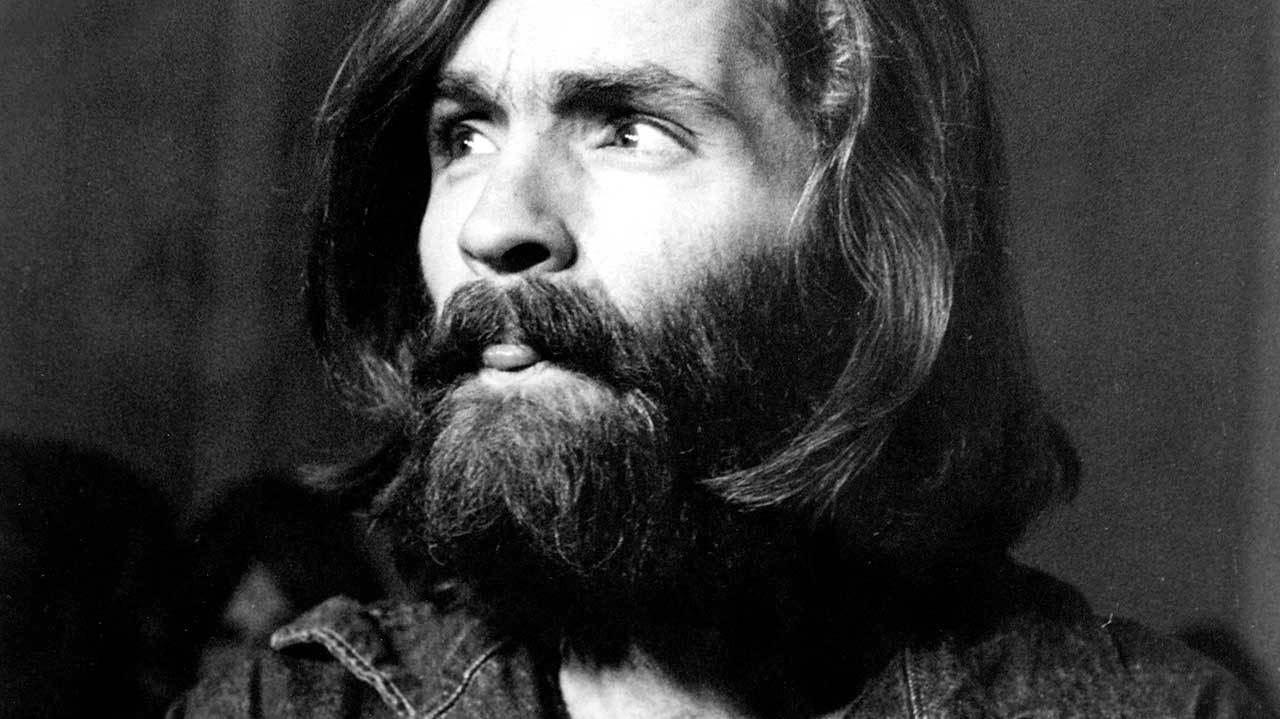Charles Manson was a petty criminal and struggling singer-songwriter way before he became world-famous as the leader of murderous cult The Manson Family. From connections with Dennis Wilson of the Beach Boys and the secret messages he found in recordings by The Beatles, here are 14 ways that Manson influenced – and was influenced by – rock music.
1. He was taught to play guitar by Alvin “Creepy” Karpis, one time Public Enemy #1, and the longest-serving inmate at Alcatraz prison.
Manson was in McNeil Island Penitentiary in Washington state at the same time as Karpis and asked the older man for guitar lessons. It’s the early 60s. Manson is obsessed with a new band from England and when he leaves prison, now able to play (“a fast learner,” says Karpis), he tells his tutor he’s going to be “bigger than the Beatles”.
2. Beach Boy Dennis Wilson introduced him to the LA music scene
Malibu, 1968: Dennis Wilson picks up two female hitchhikers, Patricia Krenwinkel and Ella Jo Bailey and they offer to introduce him to their “guru”. Dennis, impressed by the women and the free love culture surrounding Manson, starts hanging with the Family at the Spahn Ranch. He thinks Manson has some songwriting talent, produces Manson at the Beach Boys’ studio and introduces him to producer Terry Melcher, son of Doris Day.
Dennis then records one of Manson’s songs for the Beach Boys. Originally titled Cease to Exist, Wilson reworks and and renames it Never Learn Not to Love. When the song is released as a B-side, Manson is uncredited and promptly threatens to kill him.
Around this time, intimidated by violence he’s seen around the Spahn Ranch, Terry Melcher refuses to sign Manson to his label and cuts ties. Melcher’s Hollywood house at 10050 Cielo Drive, is later rented by director Roman Polanski and wife Sharon Tate which may be why that house in particular is targeted.
3. Manson hears messages in The Beatles’ Helter Skelter and comes up with a crazy apocalyptic theory…
The White Album became the set text for Manson’s deranged teachings. Poring over the album at the LA ranch that served as the headquarters for his ‘family’ of junkies and drop-outs, Manson weaved interpretations into the lyrics and formed his own terrifying subtext. On Revolution 9, he heard the Beatles encouraging him to send them a telegram. Rocky Racoon referred to a ‘coon’ [ie a black person] while Blackbird was a warning of an imminent black uprising. Helter Skelter, he took as a personal message from the Beatles to bring on the end of the world, and give “a damn good whacking” to the “bigger piggies in the starched white shirts” [ie. the bourgeois classes] from Harrison’s Piggies.
Manson acted on his delusional theories on August 8, 1969, when he ordered four members of the family to the former home of Terry Melcher (the Byrds producer who had previously rejected Manson’s musical efforts), which by this point was owned by the film director Roman Polanski. The five people at the house that night were slaughtered with knives – even Polanski’s wife, Sharon Tate, who was just two weeks from giving birth – before the word ‘PIG’ was written on the front door in blood.
The following night, the Family went to the home of Leno and Rosemary LaBianca and brutally murdered the couple, writing “Death to pigs” on the walls and “Healter [sic] Skelter” on the fridge door.
4. He killed the 60s dream…
The murders are often referred to as the “death of the 60s” – turning the dream of consciousness expansion and the rise of alternative culture into a nightmare.
“It was upsetting,” Ringo Star commented years later. “I mean, I knew Roman Polanski and Sharon Tate and - God! - it was a rough time. It stopped everyone in their tracks because suddenly all this violence came out in the midst of all this love and peace and psychedelia. It was pretty miserable, actually, and everyone got really insecure - not just us, not just the rockers, but everyone in LA felt: ‘Oh, God, it can happen to anybody.’”
5. …And the image of hippies everywhere
The image of the ‘harmless hippy’ into peace and love was tarnished too. George Harrison commented: “Another thing I found offensive was that Manson suddenly portrayed the long hair beard and moustache kind of image, as well as that of a murderer. Up until then, the long hair and the beard were more to do with not having your hair cut and not having a shave - a case of just being a scruff or something.”
6. Neil Young thought Manson was a poet
Neil Young met Manson two or three times while he lived in LA — introduced by Dennis Wilson, of course — and ended up writing On The Beach’s Revolution Blues about Manson.
“He had this kind of music that nobody else was doing,” Young told writer Bill Flanagan. “He would sit down with a guitar and start playing and making up stuff, different every time. It just kept comin’ out, comin’ out. Then he would stop and you would never hear that one again. Musically, I thought he was very unique. I thought he had something crazy, something great. He was like a living poet.”
7. Manson Family member Bobby Beausoleil supplied the soundtrack for Lucifer Rising after Jimmy Page dropped out
Truman Capote’s interview with Bobby Beausoleil suggests that the Tate-LaBianca murders were prompted by a desire to get Family member Bobby Beausoleil off the hook for murder. Beausoleil had just been arrested for the murder of Gary Hinman and had written the words “Political Piggy” on the wall in Hinman’s blood, in an attempt to convince police that the murder has been committed by Black Panthers. Manson planned to do other murders in a similar style, to convince police that they had locked up the wrong man.
Beausoleil had been a member of Arthur Lee’s pre-Love group, The Grass Roots, and had done some acting for Kenneth Anger, including appearing in footage that was marked for the film Lucifer Rising. Anger talked with Beausoleil about him doing the soundtrack.
In the early 70s, with Beausoleil in prison for Hinman’s murder, Anger turned to Jimmy Page for the soundtrack. When the two men later fell out, Beausoleil recorded the soundtrack in prison.
Jimmy Page’s version was finally released in 2012.
8. Sonic Youth’s Death Valley ‘69 is about Manson
Manson planned to avoid what he called Helter Skelter, a forthcoming race war, by hiding out in a secret city he thought was located under Death Valley, California. Yup, he was batshit crazy. Later, Sonic Youth wrote a song about it, with murderous lyrics and a violent video, hiring Lydia Lunch to provide some suitably sinister vocals.
9. Guns N’ Roses covered one of his songs
The Spaghetti Incident? track Look at Your Game, Girl is a Manson original from his album Lie: The Love and Terror Cult, released in 1970.
The GN’R cover version was included as a secret track and caused considerable controversy. Only Axl Rose and Dizzy Reed perform on the track, with the acoustic guitar played by session musician Carlos Booy. Eventually, Manson’s share of the royalties was assigned to the family of Manson victim Wojciech Frykowski.
10. The Ramones’ Glad To See You Go is about Manson
Lovers of all things bad-taste, the Ramones kicked off their second album, Leave Home, with Glad To See You Go, written from the perspective of a murderer who fantasises about getting fame through violence, like Manson: ‘Gonna smile, I’m gonna laugh they’re gonna want my autograph/And in a moment of passion get the glory like Charles Manson’.
11. The band Kasabian are named after a Manson Family member
Linda Kasabian became the prosecution’s key witness during the murder trials and was granted immunity from prosecution as a result. Some of the Family counter-claimed that, in fact, Kasabian had been the mastermind all along (a claim rejected by the jury and later rescinded by former Family members).
Former guitarist Chris Karlof picked the name after reading a book about Manson, but just because he thought “the word was cool”.
12. Trent Reznor moved into to the Tate Murders house – and recorded there
Trent Reznor bought and moved into 10050 Cielo Drive, the scene of the Tate murders. Reznor claimed that he didn’t know the house’s history at first. Nine Inch Nails’ breakthrough album The Downward Spiral was recorded there and the video for Gave Up was filmed at the house.
”Sometimes I’d come home and find bouquets of dead roses and lit candles in the front gate,” Reznor said. ”It was really eerie. Who were they leaving the shrines for — Tate or Manson?” Later, the frontman took the front door as a lovely momento of his time there. How sweet.
- Subscribe to Classic Rock and save up to 35% this Christmas!
- The Beatles: How The White Album Changed Everything
- This is Charles Manson's letter to Marilyn Manson
- Beach Boys Pet Sounds 50th anniversary package detailed
13. System Of A Down wrote a song about Manson’s, like, lovely side
Toxicity’s ATWA is a reference to a term coined by Manson to explain his environmental beliefs and an acronym for Air, Trees, Water, Animals.
“It’s something that he tends to really be focused on,” guitarist Daron Malakian once said. “The Charles Manson everybody sees on television – everything is always one-sided on television … I don’t agree with killing anybody. I don’t agree with going in and slashing anybody’s throats or anything, writing shit on the walls. That’s not what I’m into. That’s not the side of the Charles Manson that I’m into. It’s more of his ideas and his thoughts on society.”
14. He ‘Stole’ Helter Skelter. But it’s OK, U2 stole it back.
Siouxsie and the Banshees played on the Manson connection for their nightmarish cover of Helter Skelter in 1978. Ten years later, U2’s cover of the song opened 1988’s Rattle And Hum album with Bono claiming: “Charles Manson stole this song from The Beatles. We’re stealing it back.” Thanks, Bono.

